Parts made of composite materials are especially prone to shape deviations due to the highly anisotropic material properties. This phenomenon is commonly referred to as warpage and is caused by changes in temperature or polymer morphology. Whether these residual strains will contribute to warpage depends on where they occur and how they combinedly act on part level. Hence, the magnitude of warpage strongly depends on processing conditions, fiber orientation, and material properties.


Warpage simulation allows to predict the final part shape, considering the outlined effects. Our simulation approaches allow to check if intended geometrical tolerances will be violated and whether this will cause problems during subsequent assembly. Moreover, warpage simulation allows to optimize the manufacturing process to reduce shape distortion without the need for expensive experimental trials.

SimuWarp, our Abaqus add-on for composites warpage simulation, empowers Abaqus to be used to predict warpage. Beyond that, SimuWarp is fully integrated into upstream process simulation results and downstream FEA analysis.

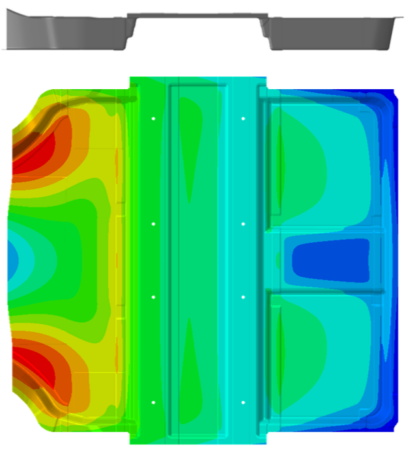
Warpage analysis of a composite car floor structure manufactured using resin transfer molding (RTM)
Key features
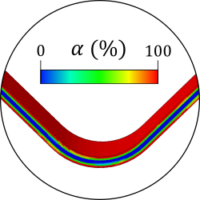
Thermokinetic simulation
A precise analysis of the heating and cooling processes is vital for predicting process-induced residual strains. Our simulation tools accurately model the temperature distribution and contain sophisticated models to derive shrinkage strains due to cross-linking or crystallization. This analysis can be done either as part of a fully featured warpage simulation or standalone, e.g., for a quick assessment of a cooling system design.

Structural performance assessment
Predicting process-induced residual stresses enables a better estimation of the expected performance of the part. Important aspects are, for instance, fatigue or strength. Transferring the warpage simulation results to other numerical models can be achieved using SimuChain.

Warpage prediction of components
Warpage is caused by shrinkage strains due to changes in temperature or morphology of the polymer. Depending on the applied thermal boundary conditions, stress gradients in the through-thickness direction lead to a deformation of the part’s shape. When using composite materials, the distribution and orientation of fibers are additional sources of stress gradients. Calculating the resulting stress state enables to predict the corresponding part deformation and to check whether prescribed tolerances will be met.

Warpage optimization
A warpage simulation incorporates many aspects defined during part and process design. It can therefore be utilized to determine the sensitivity of the resulting part shape with respect to these design variables. Among others, this allows minimization of warpage or a deliberate adjustment of the part’s shape. The latter might be used to provoke a specific residual stress state which is beneficial for the targeted application of the part.
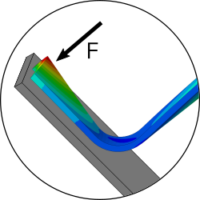
Warpage prediction of assemblies
If a warped component is part of a larger assembly, deformation of the individual component and connected parts will occur after mounting. This deformation can be predicted by incorporating the assembly into the simulation model without the need to conduct expensive experimental trials.
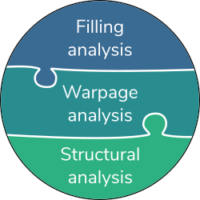
Continuous integration in CAE chains
SimuWarp can be integrated with existing CAE tool chains to import initial conditions like fiber orientation or temperature from preceding simulations. Similarly, the results of SimuWarp can be exported for use in downstream numerical analyses. This result transfer (mapping) can be achieved using, e.g., SimuChain and allows to accompany the creation of a part during manufacturing in a holistic way and provides essential input data for estimating the expected component performance.
Materials & Technologies
Our warpage simulation add-on SimuWarp supports materials and processes relevant to large-scale production. This includes continuously and discontinuously reinforced composites based on thermosetting and thermoplastic matrix systems. Moreover, hybrid material designs, e.g. a combination of LFT and unidirectional tapes, are also supported.

Continuously fiber-reinforced composites
Continuously fiber-reinforced composites are modeled in SimuWarp in form of laminates which usually consist of several differently oriented plies. The local fiber orientation of these individual plies is the result of a forming process step and an important quantity for accurate prediction of warpage. Forming of such a stack of textiles therefore needs to be predicted beforehand e.g. by using SimuDrape.
Supported manufacturing processes:
- Compression molding of thermoplastic tape laminates, Organosheets or thermoset prepregs
- Resin transfer molding processes based on dry engineering textiles like non-crimp fabrics (UD-NCF) or woven fabrics

Discontinuously fiber-reinforced composites
Parts made of discontinuously fiber-reinforced composites are shaped during a molding process. As this involves a significant flow of the filled polymer material, important properties like fiber orientation or temperature are constantly altered during mold filling. The resulting spatial distribution of such properties are vital input parameters for a meaningful warpage simulation. SimuFill allows to calculate the required data beforehand while SimuChain can be used to transfer the data to the warpage simulation model.
Supported manufacturing processes:
- Compression molding of long-fiber-reinforced thermoplastics (LFT), glass mat thermoplastics (GMT) and sheet molding compound (SMC)
- Injection molding with or without fibers
Material card creation
We are your one-stop supplier for material card creation. Depending on your desired degree of complexity, we tailor the testing program for the targeted process and material. For this, we make use of the following well suited characterization setups and testing methods.
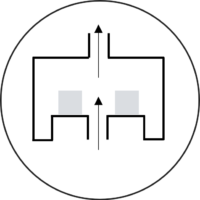
Kinetics
Crosslinking and crystallization significantly impact the development of the mechanical properties of the composite and the build-up of residual strains. We offer several state-of-the-art characterization techniques for thermosetting and thermoplastic materials:
- Flash DSC, fast DSC, and conventional DSC (Differential scanning calorimetry) for reaction kinetics of thermosets and crystallization kinetics of thermoplastics
- TGA (Thermogravimetric analysis) for determination of polymer content

Mechanical properties
Properties of thermosetting and thermoplastic materials vary significantly throughout the manufacturing process. Besides influence from cross-linking or crystallization, the mechanical behavior also heavily depends on temperature and strain rates. To characterize these effects, we offer the following well suited measurement techniques:
- Rheometer measurements with isothermal and non-isothermal temperature profiles for determination of temperature and time dependent changes of mechanical properties
- DMA (Dynamic mechanical analysis) for measurement of viscoelastic properties of thermosets and thermoplastics

Thermal expansion and shrinkage
Process-induced residual strains leading to warpage comprise contributions from changes in temperature and the polymer’s morphology. We offer the following standard characterization methods:
- TMA (Thermomechanical analysis) for thermal expansion measurement of thermosets and thermoplastics
- Rheometer gap measurement for determination of chemical shrinkage of thermosets
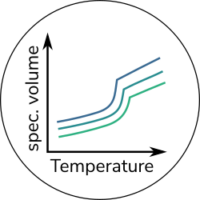
Thermophysical properties
Temperature is a crucial process quantity as it influences many important material and process properties. However, the spatial distribution of temperature constantly changes during processing. Its prediction requires knowledge of thermophysical properties, e.g. glass transition temperature, thermal conductivity, heat capacity, and density. For this, we can offer several measurement methods:
- Capillary rheometer for characterizing pvT (pressure-volume-temperature) behavior and heat conductivity of thermosets and thermoplastics
- DSC (Differential scanning calorimetry) for determination of the heat capacity of the polymer
References & Publications
Our methods are tested and validated for geometries with practice-relevant complexity and size. Check out our case studies and publications.
Warpage simulation for thermoplastic injection molding
SimuWarp was benchmarked in a collaboration project with the Robert Bosch GmbH. Material cards for different materials have been generated and the results of warpage predictions were correlated to experimental tests. A good agreement between simulation and experiments proves the prediction accuracy of SimuWarp.
Publications
- Bernath: Numerical prediction of curing and process-induced distortion of composite structures (Dissertation), Karlsruhe: KIT Scientific Publishing, 2021
- Bernath et al.: Experimental and numerical study of the spring-in of angled brackets manufactured using different resins and fiber textiles, Journal of Composite Materials, 53(28-30), p. 4173-4188, 2019
- Henning et al.: Fast processing and continuous simulation of automotive structural composite components, Composites Science and Technology, 71, p. 261-279, 2019
- Bernath et al.: Accurate Cure Modeling for Isothermal Processing of Fast Curing Epoxy Resins, Polymers, 8(11), p. 390, 2016
Any Questions?
Do not hesitate to get in contact with us. We are pleased if you leave us a message!

